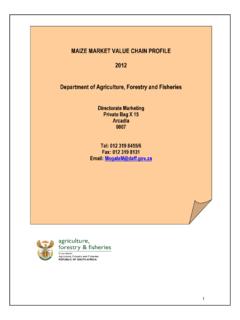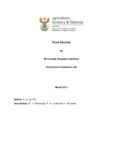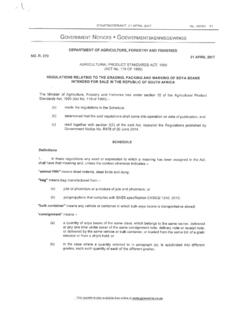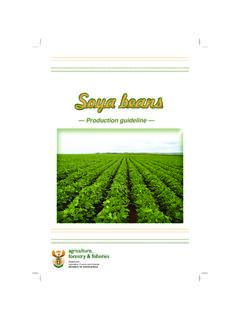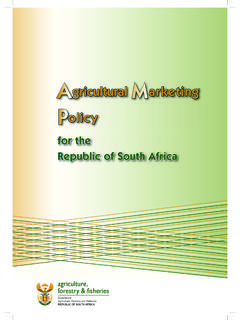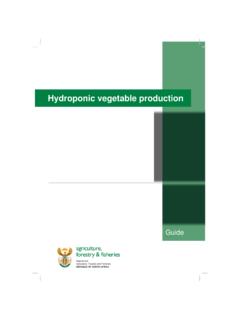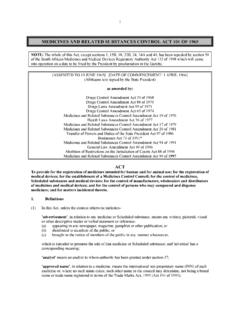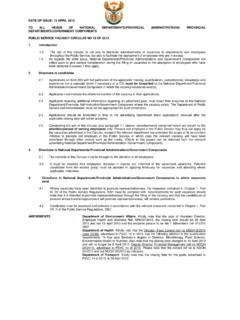Transcription of Compiled by the ARC Department of Agriculture
1 Compiled by the ARC for the Department of Agriculture This manual was Compiled to fulfill the institutional mandate of technology transfer and information dissemination. TABLE OF CONTENTS Page BBBEEEEEEFFF PPPRRROOODDDUUUCCCTTTIIIOOONNN IIINNN SSSOOOUUUTTTHHH AAAFFFRRRIIICCCAAA OOOPPPPPPOOORRRTTTUUUNNNIIITTTIIIEEESSS AAANNNDDD BBBEEEEEEFFF PPPRRROOODDDUUUCCCTTTIIIOOONNN VVVEEELLLDDD MMMAAANNNAAAGGGEEEMMMEEENNNTTT AAANNNDDD GGGRRRAAAZZZIIINNNGGG NNNUUUTTTRRRIIITTTIIIOOONNN AAANNNDDD CCCOOONNNDDDIIITTTIIIOOONNN CCCAAALLLFFF BBBEEEEEEFFF PPPRRROOODDDUUUCCCTTTIIIOOONNN IIINNN SSSOOOUUUTTTHHH AAAFFFRRRIIICCCAAA --- OOOPPPPPPOOORRRTTTUUUNNNIIITTTIIIEEESSS AAANNNDDD
2 CCCHHHAAALLLLLLEEENNNGGGEEESSS Most government programs support the development of emerging farmers through technology transfer and market development. A large percentage of beef cattle are in the hands of these developing farmers of which only a few make it into the commercial market. More than 70 % of the commercially available beef comes from the feedlot. In the past decade, white meat and pork has gained momentum which has resulted in a suppressed red meat market. Imported beef also makes it difficult for local players. However, the deregulation and liberalization of the South African agricultural sector has brought with it many challenges and opportunities.
3 The challenges and opportunities covers issues ranging from market development, the assessment global and domestic markets, understanding of new value chains, international trade to issues pertaining to policy design and implementation, upliftment of the rural poor and information provision. These issues can only be addressed in a comprehensive and efficient manner by taking cognizance of the deficiencies that exist in the agricultural milieu within South Africa. However, for success it is necessary to lay down proper plan of activities. BBBEEEEEEFFF PPPRRROOODDDUUUCCCTTTIIIOOONNN SSSYYYSSSTTTEEEMMMSSS There are three main types of beef production systems: - Cow-calf production - mainly produces calves for sale.
4 - Purebred breeding - produce bulls for the cow-calf operation - Slaughter cattle production - cattle from the cow-calf system are fattened for slaughter The type of the system will determine the feeding and management plan to be implemented. VVVEEELLLDDD MMMAAANNNAAAGGGEEEMMMEEENNNTTT AAANNNDDD GGGRRRAAAZZZIIINNNGGG SSSYYYSSSTTTEEEMMM Before grazing system is considered, camps must be properly fenced off. When putting up camps on a farm, veld variation must be considered to prevent area selective grazing. A prerequisite for maximum production is a sufficiently high intake of nutrients to ensure that the animal can grow and produce after maintenance requirements have been met.
5 High intake occurs only when an adequate quantity of quality forage is available. Quantity is dependent on stocking rate, separating veld variations and grazing to correct height. Quality is dependent on grazing period, grass species and soil fertility. Figure 2: Basic principles of veld management (Adapted from Ivy and Ivy, 1984). Soil erosion has encroached to more than 50% in the last century. This has affected the productive capacity of the land. As farmers we are really neither stock nor grass farmers but primarily soil farmers. Stock can be replaced overnight, grass reclaimed in a decade but one inch of soil take a thousand years to form from rock.
6 A thin layer of soil stands between food for all mankind and national disaster though hunger, thirst and disease. As a farmer, know the grass types that the cattle like and those they do not like palatable and unpalatable grasses. Such knowledge is important in designing a grazing system and making informed management decisions. Camps may be rotationally grazed based on the season and veld type. Example of common palatable grass species: Panicum maximum Cynodon datylon Urochloa mosambicensis Examples of common unpalatable grass species: Cymbopogon spp Eragrostis curvula Aristida spp.
7 The objective of veld management is to provide a good soil cover of edible/palatable and perennial grass plants that will ensure long-term sustainable animal production, with maximum financial return. Why manage veld? Differences in the palatability and nutritive value of individual grass species. - Animals graze selectively. - Grass plants react differently to grazing treatments. - Good animal production is only possible when animals have access to enough palatable grasses. How is the veld managed? By managing the type, number and distribution of animals. - Type = grazers and/or browsers - Number = stocking rate (ha/LSU) - Distribution == grazing system ( Fodder Bank System) Principle do's and don'ts 1.
8 Know the different grass species and their grazing values. 2. Realise that all grasses are not equally suited for grazing. Palatable perennial grasses are the main fodder source. 3. Plan the management of your farm and construct fences according to vegetation types. 4. Realise that good animal production is only possible when animals have access to enough palatable grasses. 5. Remember that cattle are primarily grazers and will only browse when the grass are over grazed. 6. Don't overstock and adapt animal numbers seasonally according to the prevailing climatic conditions. 7. Don't overgraze. Leave enough grass behind for regrowth (take half leave half!)
9 8. Veld must rest in the growing season. Rotational grazing does not necessarily mean rest. 9. Keep record of the number of animals and the number of days that they spent grazing in a camp. 10. Organic material on the ground and an abundance of perennial grass species are positive signs. Prerequisites before a system can be applied: * Carrying capacity - no system works if the veld is overgrazed by too many cattle. Regularly reduce cattle numbers. Reduce early in April in dry years. Value of correct stocking (sweetveld) Season Cattle (LSU)/100ha Kilograms meat/100ha Held health Wet 17 1400 Down Wet 11 2100 Up Dry 9 1800 Up * Camps.
10 There must be a sufficient number to apply a system of rotational grazing and resting. Figure 3. Sample of camp layout Value of rotating veld - sufficient resting Tawoomba Research Station 40 years Resting Kgs Meat /100 ha Veld Health No rest 2000 Down 3300 Up Signs of overgrazing or low capacity are: thin cattle at the end of winter; a high percentage of old land and an abundance of grass pioneers; erosion, bush encroachment and damage due to termites and game. These are clear-cut signs that stock numbers should be reduced.
